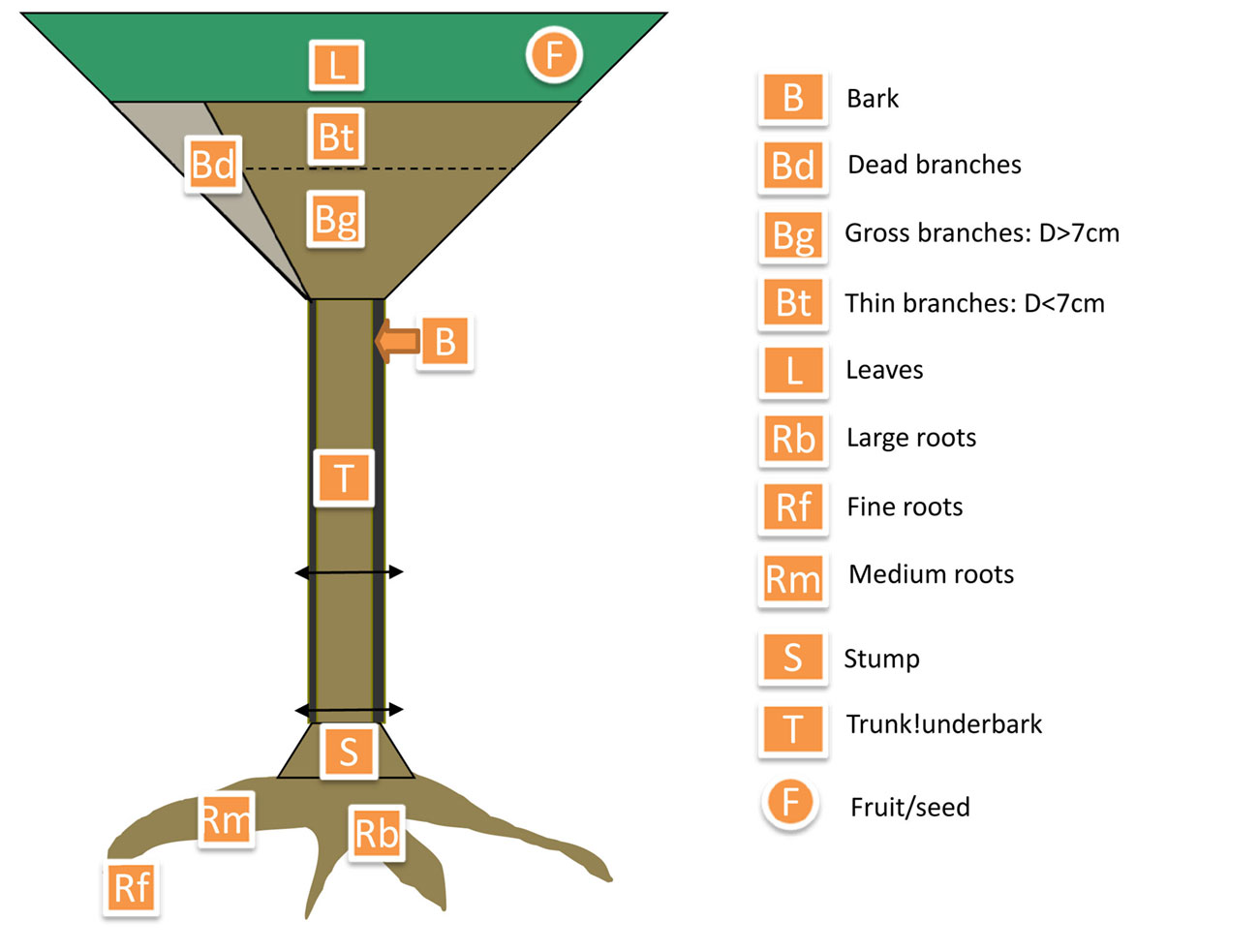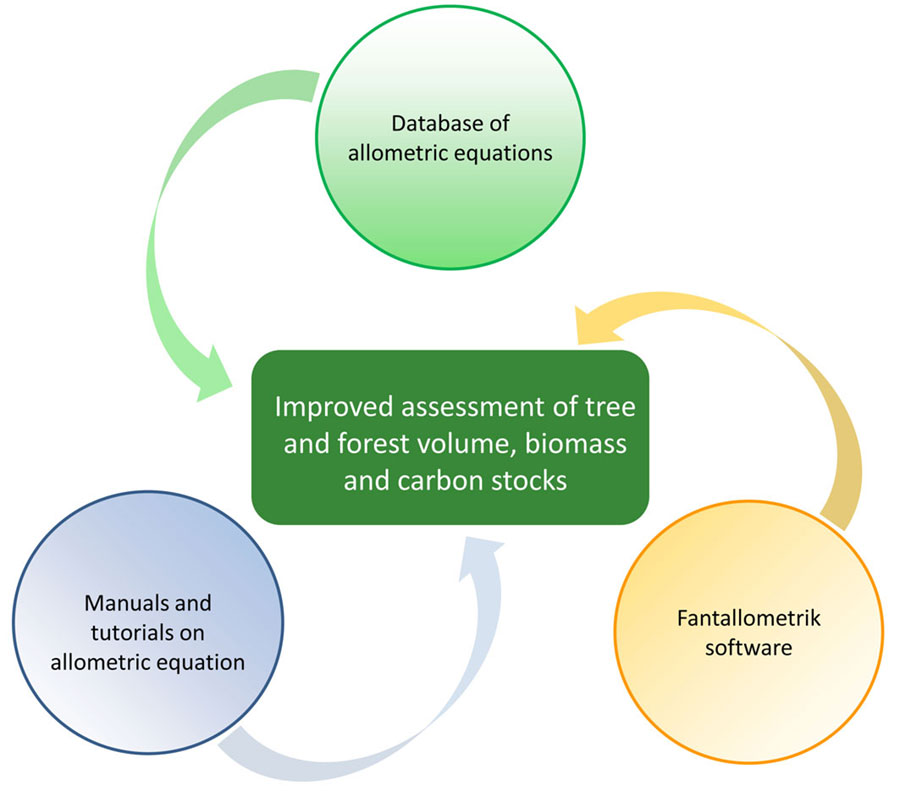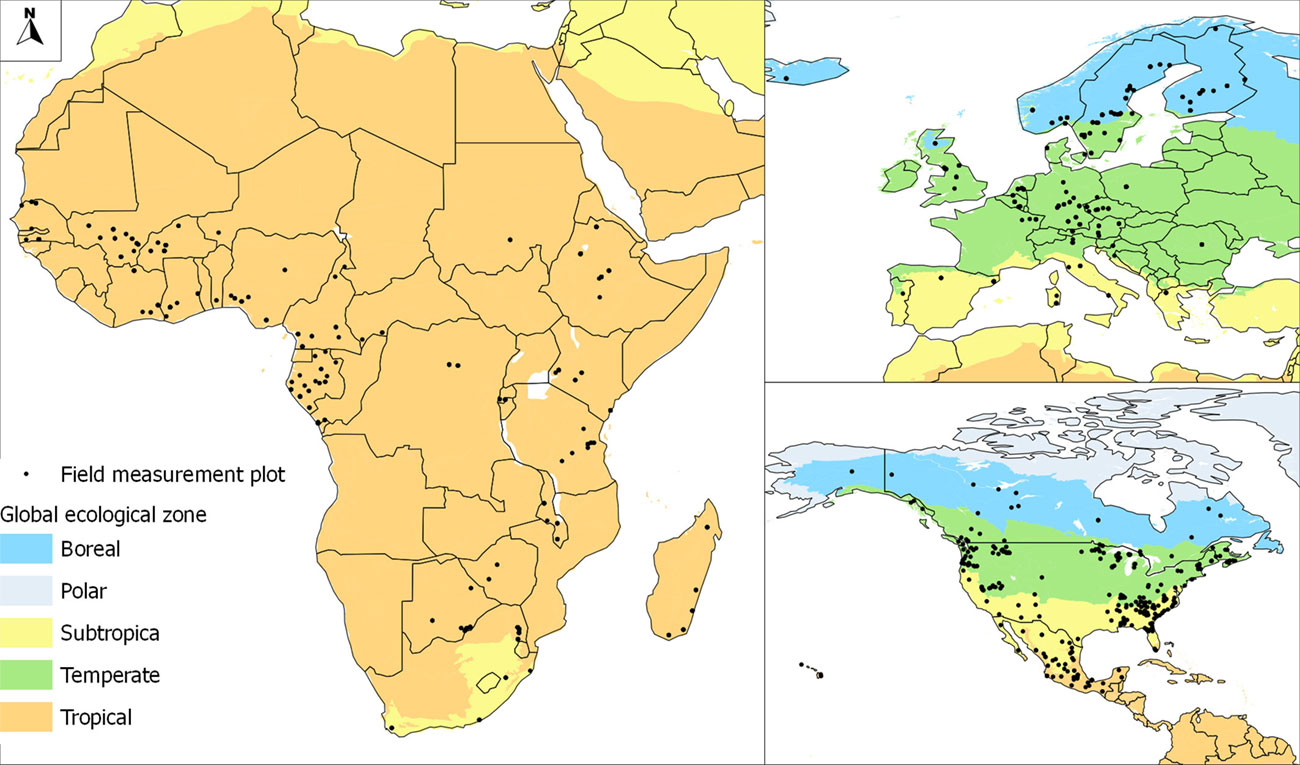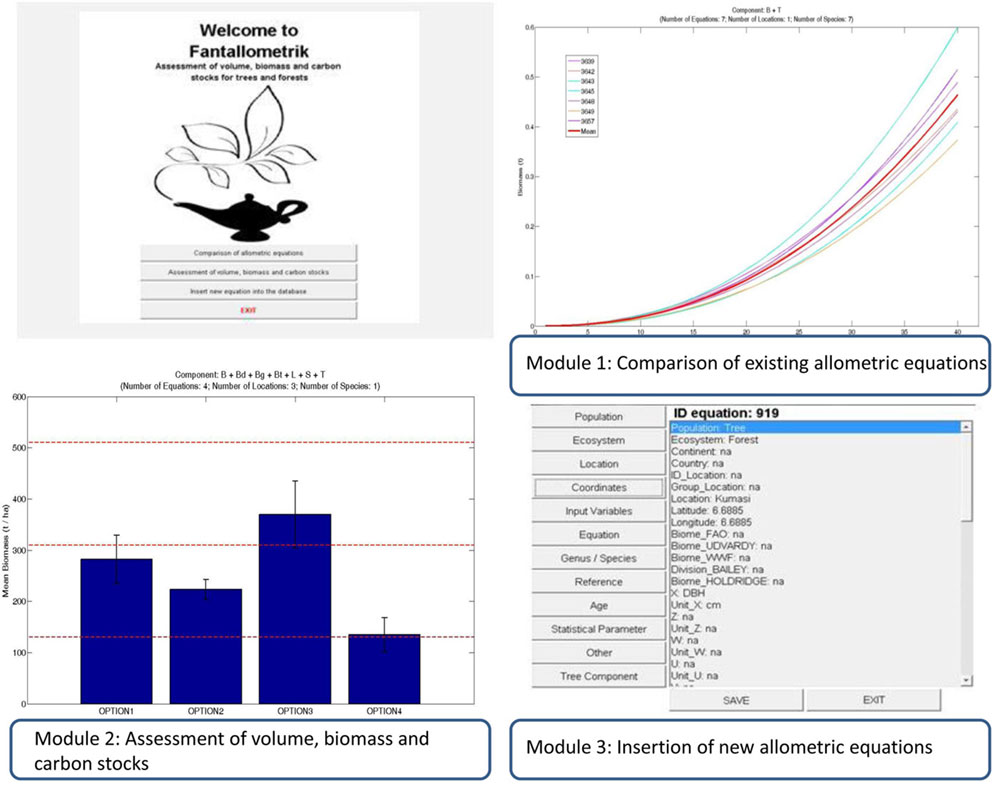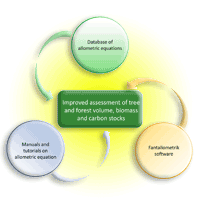
GlobAllomeTree: international platform for tree allometric equations to support volume, biomass and carbon assessment
iForest - Biogeosciences and Forestry, Volume 6, Issue 6, Pages 326-330 (2013)
doi: https://doi.org/10.3832/ifor0901-006
Published: Jul 18, 2013 - Copyright © 2013 SISEF
Technical Reports
Abstract
GlobAllomeTree is an international platform for tree allometric equations. It is the first worldwide web platform designed to facilitate the access of the tree allometric equation and to facilitate the assessment of the tree biometric characteristics for commercial volume, bio-energy or carbon cycling. The webplatform presents a database containing tree allometric equations, a software called Fantallomatrik, to facilitate the comparison and selection of the equations, and documentation to facilitate the development of new tree allometric models, improve the evaluation of tree and forest resources and improve knowledge on tree allometric equations. In the Fantallometrik software, equations can be selected by country, ecological zones, input parameters, tree species, statistic parameters and outputs. The continuously updated database currently contains over 5000 tree allometric equations classified according to 73 fields. The software Fantallometrik can be also used to compare equations, insert new data and estimate the selected output variables using field inventory. The GlobAllomeTree products are freely available at the URL: ⇒ http://globallometree.org for a range of users including foresters, project developers, scientist, student and government staff.
Keywords
Forest Assessment, LULUCF, Trees Outside Forests, Database, Software, Communication
Introduction
The techniques for evaluation of forest resources, whether for estimating the volume, biodiversity, bio-energy or carbon are constantly evolving ([12], [24]). The estimation of forest land area has continuously been improved and particularly with advances in terms of remote sensing ([5], [7]). Regarding the estimation of forest variables such as volume, biomass and carbon stocks, the continually increasing number of forest models and tree allometries has contributed to improve the estimation of forest biomass per tree, sprout or stands ([10]). As part of the introduction of systems for payments for ecosystem services, and particularly to enhance climate change mitigation activities, it is crucial to improve the accuracy of the estimates of emissions by sources and removals by sinks ([21], [28]). Advances in scientific forestry research should contribute substantially to the establishment of a future climate regime since land use change emissions 1.1 Pg C yr-1 - mainly from tropical deforestation - accounted for 12.2% of global anthropogenic greenhouse gases (GHG) emissions between 2000 and 2009 ([6]). However, large uncertainties (± 0.7 Pg C yr-1 ) still exist, the most part stemming from the lack of consistent and wide application of models for estimating biomass ([2], [14], [20]).
The most common method to assess forest biomass is based on tree allometric equations combined with forest inventories. Tree allometric equation relates wood volume or that of several tree components to stem diameter at breast height and/or to tree height and/or other dendrometric variables. Different methods exist for developing tree allometric equations depending on the objective (commercial volume, bio-energy, biomass or carbon), forest type (mono-specific plantation or pluri-specific forest), tree size, accessibility of the tree, forestry law, technical, financial and human capacities ([18]). As a consequence, the quality of the biomass estimates varies among allometric equations and depends on how the allometry has been constructed.
Since the development of stem volume and biomass equations is a laborious and time-consuming process - especially the destructive harvesting of large trees - existing equations need to be compiled, compared and evaluated to facilitate identification of the gaps in the coverage of equations. The compiled equations can also be used to test and compare existing equations with new ones, as well as to validate process-based models. Although the number of available allometric equations has increased significantly in recent years, estimates of biomass have not necessarily improved. Biomass equations had been compiled for tropical, subtropical, temperate, and boreal trees or forests ([1], [4], [10], [11], [17], [22], [23]). However, biomass equations for some ecosystems such as shrubland ([16]) or continents such as Africa ([3]) remain understudied. In addition, the access to documents reporting tree allometric equations is limited. Most of them are found in the scientific literature to which access is restricted. Currently, national and continental databases for allometric equations are few ([9], [17], [29]) and should be continually updated. In addition, the existing databases are not harmonized and data are often not comparable. Indeed, allometric equations correspond to different tree components (Fig. 1), different forest and management types, different intervals of validity and the estimated variables cannot be compared without preliminary alignment steps.
Fig. 1 - Different tree components as proposed by Henry et al. ([10]).
The choice of the most accurate allometric equation for biomass estimation is difficult in two cases ([9]). First, more than one allometric equation may be available for a tree species and for a given ecological zone. Second, there may be no allometric equation for a given species or ecological zone or the available equations could not be reliable. It is crucial to have access to allometric equation databases to ascertain these potential issues. In both cases, several authors offer solutions taking into account the impact of the selected equation on carbon stocks and potential emission reduction calculations ([8], [14]).
Software and computer programs have largely contributed to improving forest estimates and facilitating the procedures of calculation ([13], [15], [19], [27]). Widely used in developed countries, these softwares are usually specific to a country or an ecological zone. Currently, no software accounts for the great diversity of allometric equations, national circumstances and specific ecological zone classification.
The objective of this paper is to present the online platform “GlobAllomeTree” and our efforts to facilitate the development of a global tree allometric equations database and a software for volume, biomass and carbon assessment, using all existing source of allometric equations, but also to facilitate access to all the information related to tree allometric equation development.
An internet platform to facilitate access to tree allometric equations
The GlobAllomeTree online platform provides: (1) a consistent and harmonized database of tree allometric equations for volume, biomass and carbon assessment of trees at the global scale; (2) a software to estimate the variables of interest such as volume, biomass and carbon stocks taking into account the existing tree allometric equations; (3) easy access to scientific research information on allometric equation and assessment of volume, biomass and carbon stocks; and (4) access to tutorials and manuals supporting the use and the development of tree allometric equations (Fig. 2).
The platform is a unique and allows for the first time access to data that are generally difficult to access, either because they are in scientific journals, either because they are found in electronic documents or remote libraries. The tools provided are complementary and allow users to implement various steps from the field measurement to the prediction of volume, biomass or carbon stock. Data are available for different types of vegetation, from mangrove to plantations, from individual trees to stands. The tools target a large number of users, both for the assessment of forest resources and trees outside forests. Among the main users are people working on forest resource assessment (bio-energy trade volume, carbon stocks), scientists working on the dynamics of forest biometrics, forest technicians, students, and project developers involved in management of natural resources, especially forests.
Tree allometric database to facilitate comparison and selection of allometric equation
The web platform GlobAllomeTree provides free access to one global database for existing volume, biomass and carbon allometric equations for the different tree components identified in Fig. 1. The equations were georeferenced when possible from the original information. In some cases, it was not possible to access the original documents and the equations were not georeferenced. In the first version of the database, the number of equations is 706 for Europe (100% georeferenced equations), 2843 for North America (74% georeferenced equations), and 1058 for Africa (66% georeferenced equations - Fig. 3).
Fig. 3 - Geographic distribution of the georeferenced tree allometric equations in Africa (A), Europe (B) and North America (C).
Users can freely filter the database according to their needs (volume, biomass, carbon, edible foliage biomass, location, country, ecological zone etc). The software has been developed to cover many possible uses. The data were classified according to 5 ecological zone classifications (Holdridge, WWF, Bailey, FAO and Udvardy ecological classifications are available at: ⇒ http://www.carboafrica.net/data_en.asp) and eleven tree components (Fig. 1), by population types (stand, individual tree, sprout), and by forest type (plantation, natural forest etc).
An utmost care has been paid to avoid any transcription error from the primary literature to the figures reported in the database. However, may errors be detected, users are encouraged to send queries for updates and the database will be changed accordingly. Users are also encouraged to submit new allometric equations and databases to enrich the platform and contribute to the efforts.
A software to use the allometric equation database and assess volume, biomass and carbon stocks
A software was developed to facilitate the assessment of the volume, biomass and carbon stocks in native and secondary forests, plantations, tree outside forests, bamboos, lianas and mangroves ([26]). The software was developed using the deploy tool made available for non-commercial use by Mathworks© (⇒ http://www.mathworks.it/help/toolbox/compiler/deploytool.html). Users can upload the existing allometric equation database made available on GlobAllomeTree or develop their own. The software contains three main modules (Fig. 4): (1) comparison of existing tree allometric equations; (2) assessment of volume, biomass and carbon stocks and automatically calculate from field measurement the volume and the biomass; (3) insertion of new allometric equations. The software is developed to give the possibility to insert new data. The user should careful read the detailed on-line guidance before starting to install and make calculations ([25]).
The first module allows the user to filter equations according to his/her needs. The second module calculates the volume, biomass and carbon stocks using the selected equations. The user can import data from a field forest inventory plots and obtain the descriptive statistics for the allometric equations considered. The third module allows the user to automatically enter new equations that were not present in previous database. Users can submit entire databases or individual allometric equations.
Conclusion
In view of the importance of carbon stock assessment in forest ecosystems, the availability of allometric equations has long been a limitation. For the first time, the GlobAllomeTree portal enables users to access all of this information at once, so as to improve quality in the assessment of forest volume, biomass and carbon stocks. This platform represents a significant advance in forestry and climate related research and application, and we hope it will help improve estimates of biomass and emissions, for mitigation options, bioenergy to name but a few. The relevance of this issue is global, but there is an urgent need especially for tropical areas, where information is often scarce. The tools proposed by GlobAllomeTree internet platform allow the broad range of users involved in the assessment of the forestry resources to improve estimates of the most important forest variables. Moreover, this tool is dynamic and interactive, allowing a continuous improvement of the available equations and the inclusion of new ones. In the future, the addition of advanced biomass expansion factors and new statistical analyses should improve biomass estimates for the different tree components and carbon pools.
Acknowledgement
The Food and Agriculture Organization of the United Nations (FAO), the Centre de Coopération Internationale en Recherche Agronomique pour le Développement (CIRAD) and the Department for Innovation in Biological, Agro-Food and Forest System at Tuscia University (UNITUS-DIBAF) jointly developed this internet platform taking profit of the experiences built from several projects. We thank the European Union for funding the research required to the development of the platform through CarboAfrica (037132) and ClimAfrica (244240) projects. We also thank the UN-REDD program, the Agence Nationale de la Recherche (via the Emerge project), GeoCarbon (283080) and Global Terrestrial Observation System for their support. We thank Dr. Jérôme Chave (CNRS) for his contribution.
References
CrossRef | Gscholar
Gscholar
Online | Gscholar
Gscholar
Gscholar
Gscholar
Gscholar
Gscholar
Gscholar
Gscholar
Authors’ Info
Authors’ Affiliation
L Birigazzi
G Sola
P Santenoise
Food and Agriculture Organisation of the United Nations, Forest Department, v.le delle Terme di Caracalla, I-00153 Rome (Italy)
R Valentini
CMCC, Euro-Mediterranean Center on Climate Change, v. Augusto Imperatore 16, I-73100 Lecce (Italy)
A Alessandrini
R Valentini
DIBAF, Università della Tuscia, v. Camillo de Lellis, I-01100 Viterbo (Italy)
CIRAD, UMR Eco et Sols, Ecologie Fonctionnelle et Biogéochimie des Sols et Agro-écosystèmes, F-34060 Montpellier (France)
INRA, UR BEF, Biogéochimie des Ecosystèmes Forestiers, F-54280 Champenoux (France)
INRA, UMR LERFoB, Laboratoire d’Etude des Ressources Forêt-Bois, F-54280, Champenoux (France)
Corresponding author
Paper Info
Citation
Henry M, Bombelli A, Trotta C, Alessandrini A, Birigazzi L, Sola G, Vieilledent G, Santenoise P, Longuetaud F, Valentini R, Picard N, Saint-André L (2013). GlobAllomeTree: international platform for tree allometric equations to support volume, biomass and carbon assessment. iForest 6: 326-330. - doi: 10.3832/ifor0901-006
Academic Editor
Marco Borghetti
Paper history
Received: Nov 16, 2012
Accepted: Jun 14, 2013
First online: Jul 18, 2013
Publication Date: Dec 02, 2013
Publication Time: 1.13 months
Copyright Information
© SISEF - The Italian Society of Silviculture and Forest Ecology 2013
Open Access
This article is distributed under the terms of the Creative Commons Attribution-Non Commercial 4.0 International (https://creativecommons.org/licenses/by-nc/4.0/), which permits unrestricted use, distribution, and reproduction in any medium, provided you give appropriate credit to the original author(s) and the source, provide a link to the Creative Commons license, and indicate if changes were made.
Web Metrics
Breakdown by View Type
Article Usage
Total Article Views: 86746
(from publication date up to now)
Breakdown by View Type
HTML Page Views: 66232
Abstract Page Views: 8052
PDF Downloads: 10256
Citation/Reference Downloads: 251
XML Downloads: 1955
Web Metrics
Days since publication: 4525
Overall contacts: 86746
Avg. contacts per week: 134.19
Article Citations
Article citations are based on data periodically collected from the Clarivate Web of Science web site
(last update: Mar 2025)
Total number of cites (since 2013): 125
Average cites per year: 9.62
Publication Metrics
by Dimensions ©
Articles citing this article
List of the papers citing this article based on CrossRef Cited-by.
Related Contents
iForest Similar Articles
Technical Reports
Allometric biomass and carbon factors database
vol. 1, pp. 107-113 (online: 09 July 2008)
Commentaries & Perspectives
What happened to forests in Copenhagen?
vol. 3, pp. 30-32 (online: 02 March 2010)
Technical Reports
A new database for time-series monitoring data: the NitroEurope approach
vol. 4, pp. 226-232 (online: 03 November 2011)
Research Articles
An approach to estimate carbon stocks change in forest carbon pools under the UNFCCC: the Italian case
vol. 1, pp. 86-95 (online: 20 May 2008)
Research Articles
An assessment of climate change impacts on the tropical forests of Central America using the Holdridge Life Zone (HLZ) land classification system
vol. 6, pp. 183-189 (online: 08 May 2013)
Review Papers
Increasing resistance and resilience of forests, a case study of Great Britain
vol. 17, pp. 69-79 (online: 21 March 2024)
Research Articles
Approaches to classifying and restoring degraded tropical forests for the anticipated REDD+ climate change mitigation mechanism
vol. 4, pp. 1-6 (online: 27 January 2011)
Technical Advances
A meta-database comparison from various European Research and Monitoring Networks dedicated to forest sites
vol. 6, pp. 1-9 (online: 14 January 2013)
Research Articles
Seeing, believing, acting: climate change attitudes and adaptation of Hungarian forest managers
vol. 15, pp. 509-518 (online: 14 December 2022)
Research Articles
Potential impacts of regional climate change on site productivity of Larix olgensis plantations in northeast China
vol. 8, pp. 642-651 (online: 02 March 2015)
iForest Database Search
Search By Author
- M Henry
- A Bombelli
- C Trotta
- A Alessandrini
- L Birigazzi
- G Sola
- G Vieilledent
- P Santenoise
- F Longuetaud
- R Valentini
- N Picard
- L Saint-André
Search By Keyword
Google Scholar Search
Citing Articles
Search By Author
- M Henry
- A Bombelli
- C Trotta
- A Alessandrini
- L Birigazzi
- G Sola
- G Vieilledent
- P Santenoise
- F Longuetaud
- R Valentini
- N Picard
- L Saint-André
Search By Keywords
PubMed Search
Search By Author
- M Henry
- A Bombelli
- C Trotta
- A Alessandrini
- L Birigazzi
- G Sola
- G Vieilledent
- P Santenoise
- F Longuetaud
- R Valentini
- N Picard
- L Saint-André
Search By Keyword

